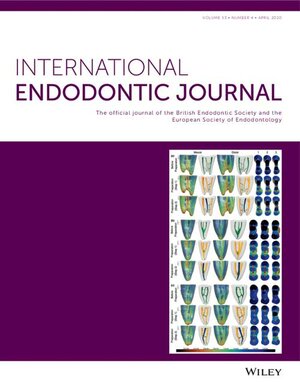A comparison of radiographically determined periapical healing and tooth survival outcomes of root canal (re)treatment performed in two care pathways within the United Kingdom Armed Forces
Abstract
Aims
To compare radiographic periapical healing and tooth survival outcomes of root canal (re)treatment performed within two care pathways (Routine Dental Care and Referred Treatment Pathway), in the United Kingdom Armed Forces (UKAF), and determine the effects of endodontic complexity on outcomes.
Methodology
This retrospective cohort study included 1466 teeth in 1252 personnel who received root canal (re)treatment between 2015 and 2020. General Dental Practitioners treated 661 teeth (573 patients) (Routine cohort), whilst Dentists with a Special Interest treated 805 teeth (678 patients) (Referred cohort). The latter group were graduates of an MSc programme in Endodontics with 4–8 years of postgraduation experience. Case complexity was retrospectively determined for each tooth using the endodontic component of Restorative Index of Treatment Need (RIOTN) guidelines. Periapical healing was determined using loose radiographic criteria. The data were analysed using chi-square tests, univariate logistic regression and Cox proportional hazards models.
Results
A significantly (p < 0.0001) larger proportion of cases of low complexity had undergone root canal treatment within the Routine versus Referred cohort. The odds of periapical healing was significantly higher within the Referred versus Routine cohort, regardless of analyses using pooled (OR = 1.17; 95% CI: 1.11, 1.22) or moderate complexity (OR = 4.71; 95% CI: 2.73, 8.11) data. Within the Routine cohort, anterior teeth had higher odds of periapical healing than posterior teeth (OR = 1.13; 95% CI: 1.04, 1.22). The 60-month cumulative tooth survival was lower (p = 0.03) in the Routine (90.5%) than the Referred (96.0%) cohort. Within the Routine cohort, the hazard of tooth loss was higher amongst posterior teeth (HR = 4.03; 95% CI: 1.92, 8.45) but lower if posterior teeth had cast restorations (HR = 0.36; 95% CI: 0.19, 0.70). For the Referred cohort, posterior teeth restored with cast restoration (vs not) had significantly lower risk of tooth loss (HR = 0.21; 95% CI: 0.08, 0.55).
Conclusions
For UKAF patients, root canal (re)treatment provided within the Referred pathway was significantly more likely to achieve periapical healing and better tooth survival than those provided within the Routine pathway. Posterior teeth restored with an indirect restoration had a higher proportion of tooth survival. This study supported the utility of the endodontic component of RIOTN for assessing case complexity.

 求助内容:
求助内容: 应助结果提醒方式:
应助结果提醒方式:


